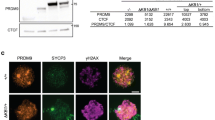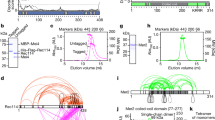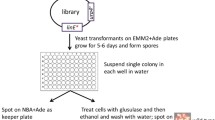Abstract
In most sexually reproducing organisms, meiotic recombination is initiated by DNA double-strand breaks (DSBs) formed by the Spo11 protein. In budding yeast, nine other proteins are also required for DSB formation, but the roles of these proteins and the interactions among them are poorly understood. We report further studies of the behaviors of these proteins. Consistent with other studies, we find that Mei4 and Rec114 bind to chromosomes from leptonema through early pachynema. Both proteins showed only limited colocalization with the meiotic cohesin subunit Rec8, suggesting that Mei4 and Rec114 associated preferentially with chromatin loops. Rec114 localization was independent of other DSB factors, but Mei4 localization was strongly dependent on Rec114 and Mer2. Systematic deletion analysis identified protein regions important for a previously described two-hybrid interaction between Mei4 and Rec114. We also report functional characterization of a previously misannotated 5′ coding exon of REC102. Sequences encoded in this exon are essential for DSB formation and for Rec102 interaction with Rec104, Spo11, Rec114, and Mei4. Finally, we also examined genetic requirements for a set of previously described two-hybrid interactions that can be detected only when the reporter strain is induced to enter meiosis. This analysis reveals new functional dependencies for interactions among the DSB proteins. Taken together, these studies support the view that Mei4, Rec114, and Mer2 make up a functional subgroup that is distinct from other subgroups of the DSB proteins: Spo11–Ski8, Rec102–Rec104, and Mre11–Rad50–Xrs2. These studies also suggest that an essential function of Rec102 and Rec104 is to connect Mei4 and Rec114 to Spo11.






Similar content being viewed by others
References
Alani E, Padmore R, Kleckner N (1990) Analysis of wild-type and rad50 mutants of yeast suggests an intimate relationship between meiotic chromosome synapsis and recombination. Cell 61:419–436
Araki Y, Takahashi S, Kobayashi T, Kajiho H, Hoshino S, Katada T (2001) Ski7p G protein interacts with the exosome and the Ski complex for 3'-to-5' mRNA decay in yeast. EMBO J 20:4684–4693
Arora C, Kee K, Maleki S, Keeney S (2004) Antiviral protein Ski8 is a direct partner of Spo11 in meiotic DNA break formation, independent of its cytoplasmic role in RNA metabolism. Mol Cell 13:549–559
Assenmacher N, Hopfner KP (2004) MRE11/RAD50/NBS1: complex activities. Chromosoma 113:157–166
Blat Y, Protacio RU, Hunter N, Kleckner N (2002) Physical and functional interactions among basic chromosome organizational features govern early steps of meiotic chiasma formation. Cell 111:791–802
Borde V, Lin W, Novikov E, Petrini JH, Lichten M, Nicolas A (2004) Association of Mre11p with double-strand break sites during yeast meiosis. Mol Cell 13:389–401
Cliften P, Sudarsanam P, Desikan A, Fulton L, Fulton B, Majors J, Waterston R, Cohen BA, Johnston M (2003) Finding functional features in Saccharomyces genomes by phylogenetic footprinting. Science 301:71–76
Cliften PF, Hillier LW, Fulton L, Graves T, Miner T, Gish WR, Waterston RH, Johnston M (2001) Surveying Saccharomyces genomes to identify functional elements by comparative DNA sequence analysis. Genome Res 11:1175–1186
Davis L, Smith GR (2001) Meiotic recombination and chromosome segregation in Schizosaccharomyces pombe. Proc Natl Acad Sci USA 98:8395–8402
Diaz RL, Alcid AD, Berger JM, Keeney S (2002) Identification of residues in yeast Spo11p critical for meiotic DNA double-strand break formation. Mol Cell Biol 22:1106–1115
Eijpe M, Offenberg H, Jessberger R, Revenkova E, Heyting C (2003) Meiotic cohesin REC8 marks the axial elements of rat synaptonemal complexes before cohesins SMC1beta and SMC3. J Cell Biol 160:657–670
Ellermeier C, Smith GR (2005) Cohesins are required for meiotic DNA breakage and recombination in Schizosaccharomyces pombe. Proc Natl Acad Sci USA 102:10952–10957
Engebrecht JA, Voelkel-Meiman K, Roeder GS (1991) Meiosis-specific RNA splicing in yeast. Cell 66:1257–1268
Gerton JL, DeRisi J, Shroff R, Lichten M, Brown PO, Petes TD (2000) Inaugural article: global mapping of meiotic recombination hotspots and coldspots in the yeast Saccharomyces cerevisiae. Proc Natl Acad Sci USA 97:11383–11390
Gietz RD, Woods RA (1998) Transformation of yeast by the lithium acetate/single-stranded carrier DNA/PEG method. Methods Microbiol 26:53–66
Henderson KA, Kee K, Maleki S, Santini PA, Keeney S (2006) Cyclin-dependent kinase directly regulates initiation of meiotic recombination. Cell 125:1321–1332
Jacobs Anderson JS, Parker R (1998) The 3′ to 5′ degradation of yeast mRNAs is a general mechanism for mRNA turnover that requires the SKI2 DEVH box protein and 3′ to 5′ exonucleases of the exosome complex. EMBO J 17:1497–1506
Jiao K, Nau JJ, Cool M, Gray WM, Fassler JS, Malone RE (2002) Phylogenetic footprinting reveals multiple regulatory elements involved in control of the meiotic recombination gene, REC102. Yeast 19:99–114
Jiao K, Salem L, Malone R (2003) Support for a meiotic recombination initiation complex: interactions among Rec102p, Rec104p, and Spo11p. Mol Cell Biol 23:5928–5938
Juneau K, Palm C, Miranda M, Davis RW (2007) High-density yeast-tiling array reveals previously undiscovered introns and extensive regulation of meiotic splicing. Proc Natl Acad Sci USA 104:1522–1527
Kassir Y, Adir N, Boger-Nadjar E, Raviv NG, Rubin-Bejerano I, Sagee S, Shenhar G (2003) Transcriptional regulation of meiosis in budding yeast. Int Rev Cytol 224:111–171
Kee K, Keeney S (2002) Functional interactions between SPO11 and REC102 during initiation of meiotic recombination in Saccharomyces cerevisiae. Genetics 160:111–122
Kee K, Protacio RU, Arora C, Keeney S (2004) Spatial organization and dynamics of the association of Rec102 and Rec104 with meiotic chromosomes. EMBO J 23:1815–1824
Keeney S (2001) Mechanism and control of meiotic recombination initiation. Curr Top Dev Biol 52:1–53
Keeney S (2007) Spo11 and the formation of DNA double-strand breaks in meiosis. In: Lankenau DH (ed) Recombination and meiosis. Springer, Heidelberg (in press) DOI 10.1007/7050-2007-026
Kellis M, Patterson N, Endrizzi M, Birren B, Lander ES (2003) Sequencing and comparison of yeast species to identify genes and regulatory elements. Nature 423:241–254
Klein F, Mahr P, Galova M, Buonomo SB, Michaelis C, Nairz K, Nasmyth K (1999) A central role for cohesins in sister chromatid cohesion, formation of axial elements, and recombination during yeast meiosis. Cell 98:91–103
Krogh BO, Symington LS (2004) Recombination proteins in yeast. Annu Rev Genet 38:233–271
Li J, Hooker GW, Roeder GS (2006) Saccharomyces cerevisiae Mer2, Mei4 and Rec114 form a complex required for meiotic double-strand break formation. Genetics 173:1969–1981
Loidl J (2006) S. pombe linear elements: the modest cousins of synaptonemal complexes. Chromosoma 115:260–271
Loidl J, Klein F, Engebrecht J (1998) Genetic and morphological approaches for the analysis of meiotic chromosomes in yeast. Methods Cell Biol 53:257–285
Lopez PJ, Seraphin B (1999) Genomic-scale quantitative analysis of yeast pre-mRNA splicing: implications for splice-site recognition. RNA 5:1135–1137
Lopez PJ, Seraphin B (2000) YIDB: the Yeast Intron DataBase. Nucleic Acids Res 28:85–86
Lorenz A, Estreicher A, Kohli J, Loidl J (2006) Meiotic recombination proteins localize to linear elements in Schizosaccharomyces pombe. Chromosoma 115:330–340
Malone RE, Pittman DL, Nau JJ (1997) Examination of the intron in the meiosis-specific recombination gene REC114 in Saccharomyces. Mol Gen Genet 255:410–419
Masison DC, Blanc A, Ribas JC, Carroll K, Sonenberg N, Wickner RB (1995) Decoying the cap− mRNA degradation system by a double-stranded RNA virus and poly(A)− mRNA surveillance by a yeast antiviral system. Mol Cell Biol 15:2763–2771
Mieczkowski PA, Dominska M, Buck MJ, Gerton JL, Lieb JD, Petes TD (2006) Global analysis of the relationship between the binding of the Bas1p transcription factor and meiosis-specific double-strand DNA breaks in Saccharomyces cerevisiae. Mol Cell Biol 26:1014–1027
Mitchell AP (1994) Control of meiotic gene expression in Saccharomyces cerevisiae. Microbiol Rev 58:56–70
Miura F, Kawaguchi N, Sese J, Toyoda A, Hattori M, Morishita S, Ito T (2006) A large-scale full-length cDNA analysis to explore the budding yeast transcriptome. Proc Natl Acad Sci USA 103:17846–17851
Moens PB, Pearlman RE, Heng HH, Traut W (1998) Chromosome cores and chromatin at meiotic prophase. Curr Top Dev Biol 37:241–262
Molnar M, Parisi S, Kakihara Y, Nojima H, Yamamoto A, Hiraoka Y, Bozsik A, Sipiczki M, Kohli J (2001) Characterization of rec7, an early meiotic recombination gene in Schizosaccharomyces pombe. Genetics 157:519–532
Moreau S, Ferguson JR, Symington LS (1999) The nuclease activity of Mre11 is required for meiosis but not for mating type switching, end joining, or telomere maintenance. Mol Cell Biol 19:556–566
Nairz K, Klein F (1997) mre11S—a yeast mutation that blocks double-strand-break processing and permits nonhomologous synapsis in meiosis. Genes Dev 11:2272–2290
Nandabalan K, Roeder GS (1995) Binding of a cell-type-specific RNA splicing factor to its target regulatory sequence. Mol Cell Biol 15:1953–1960
Nau JJ, Summers KR, Galbraith AM, Bullard SA, Malone RE (1997) Isolation of early meiotic recombination genes analogous to S. cerevisiae REC104 from the yeasts S. paradoxus and S. pastorianus. Curr Genet 31:7–14
Neale MJ, Pan J, Keeney S (2005) Endonucleolytic processing of covalent protein-linked DNA double-strand breaks. Nature 436:1053–1057
Ohta K, Nicolas A, Furuse M, Nabetani A, Ogawa H, Shibata T (1998) Mutations in the MRE11, RAD50, XRS2, and MRE2 genes alter chromatin configuration at meiotic DNA double-stranded break sites in premeiotic and meiotic cells. Proc Natl Acad Sci USA 95:646–651
Page SL, Hawley RS (2003) Chromosome choreography: the meiotic ballet. Science 301:785–789
Petronczki M, Siomos MF, Nasmyth K (2003) Un menage a quatre: the molecular biology of chromosome segregation in meiosis. Cell 112:423–440
Prieler S, Penkner A, Borde V, Klein F (2005) The control of Spo11’s interaction with meiotic recombination hotspots. Genes Dev 19:255–269
Prinz S, Amon A, Klein F (1997) Isolation of COM1, a new gene required to complete meiotic double-strand break-induced recombination in Saccharomyces cerevisiae. Genetics 146:781–795
Ramesh MA, Malik SB, Logsdon JM, Jr. (2005) A phylogenomic inventory of meiotic genes; evidence for sex in Giardia and an early eukaryotic origin of meiosis. Curr Biol 15:185–191
Richard GF, Kerrest A, Lafontaine I, Dujon B (2005) Comparative genomics of hemiascomycete yeasts: genes involved in DNA replication, repair, and recombination. Mol Biol Evol 22:1011–1023
Romanienko PJ, Camerini-Otero RD (2000) The mouse Spo11 gene is required for meiotic chromosome synapsis. Mol Cell 6:975–987
Salem L, Walter N, Malone R (1999) Suppressor analysis of the Saccharomyces cerevisiae gene REC104 reveals a genetic interaction with REC102. Genetics 151:1261–1272
Sasanuma H, Murakami H, Fukuda T, Shibata T, Nicolas A, Ohta K (2007) Meiotic association between Spo11 regulated by Rec102, Rec104 and Rec114. Nucleic Acids Res 35:1119–1133
Spingola M, Ares M (2000) A yeast intronic splicing enhancer and Nam8p are required for Mer1p-activated splicing. Mol Cell 6:329–338
Storlazzi A, Tessé S, Gargano S, James F, Kleckner N, Zickler D (2003) Meiotic double-strand breaks at the interface of chromosome movement, chromosome remodeling and reductional division. Genes Dev 17:2675–2687
Stracker TH, Theunissen JW, Morales M, Petrini JH (2004) The Mre11 complex and the metabolism of chromosome breaks: the importance of communicating and holding things together. DNA Repair (Amst) 3:845–854
Sym M, Engebrecht JA, Roeder GS (1993) ZIP1 is a synaptonemal complex protein required for meiotic chromosome synapsis. Cell 72:365–378
Tessé S, Storlazzi A, Kleckner N, Gargano S, Zickler D (2003) Localization and roles of Ski8p in Sordaria macrospora meiosis and delineation of three mechanistically distinct steps of meiotic homolog juxtaposition. Proc Natl Acad Sci USA 100:12865–12870
Umen JG, Guthrie C (1995) The second catalytic step of pre-mRNA splicing. RNA 1:869–885
van Heemst D, Heyting C (2000) Sister chromatid cohesion and recombination in meiosis. Chromosoma 109:10–26
van Hoof A, Staples RR, Baker RE, Parker R (2000) Function of the Ski4p (Csl4p) and Ski7p proteins in 3′-to-5′ degradation of mRNA. Mol Cell Biol 20:8230–8243
Wells JL, Pryce DW, Estreicher A, Loidl J, McFarlane RJ (2006) Linear element-independent meiotic recombination in Schizosaccharomyces pombe. Genetics 174:1105–1114
Xu L, Ajimura M, Padmore R, Klein C, Kleckner N (1995) NDT80, a meiosis-specific gene required for exit from pachytene in Saccharomyces cerevisiae. Mol Cell Biol 15:6572–6581
Young JA, Hyppa RW, Smith GR (2004) Conserved and nonconserved proteins for meiotic DNA breakage and repair in yeasts. Genetics 167:593–605
Zickler D, Kleckner N (1999) Meiotic chromosomes: integrating structure and function. Annu Rev Genet 33:603–754
Acknowledgments
We are grateful to Dianna Fisk (Saccharomyces Genome Database) for alerting us to the presence of the 5′ exon in REC102. We thank Nancy Kleckner, Franz Klein, Bob Malone, and Shirleen Roeder for strains, plasmids and/or antibodies. This work was supported by NIH grant R01 GM58673 (to S.K.). M.J.N. is supported in part by a fellowship from the Human Frontiers Science Program. K.H. was supported in part by a Frank Lappin Horsfall, Jr. Fellowship and an Association for Women in Science Predoctoral Fellowship. S.K. is a Leukemia and Lymphoma Society Scholar.
Author information
Authors and Affiliations
Corresponding author
Additional information
Communicated by E.A. Nigg
Electronic supplementary material
Below is the link to electronic supplementary material
Rights and permissions
About this article
Cite this article
Maleki, S., Neale, M.J., Arora, C. et al. Interactions between Mei4, Rec114, and other proteins required for meiotic DNA double-strand break formation in Saccharomyces cerevisiae . Chromosoma 116, 471–486 (2007). https://doi.org/10.1007/s00412-007-0111-y
Received:
Revised:
Accepted:
Published:
Issue Date:
DOI: https://doi.org/10.1007/s00412-007-0111-y




